First-time visitor Ryandall Lim believes that the true essence of this beautiful country lies in its many magical moments
“Too cloudy, too bad,” mumbled the flight stewardess matter-of-factly when I asked where the mountains were. I slumped back and buckled my seatbelt, disappointed that the jaw-dropping sight of snow-capped peaks so many guide books had set me up for was not to going materialise before my eyes.
But as we swooped into a dense layer of cotton-candy clouds, green patches began to slowly peep through them. Soon, an entire sea of hills revealed themselves below us – their vibrance such a jarring explosion of colour that I found myself momentarily squinting.
Like a mythical dragon making its majestic approach, the plane weaved between undulating mounds, at times coming so precariously close to steep hillsides that I imagined their inhabitant trees waving at me. Nature had erupted into a triumphant aria outside. In the cabin, passengers clutched their armrests subtly, fixated out of their tiny windows. The monotonous background engine hum and the intermittent pressure pop in my ears did little to distract from the dramatic view outside.
Then, following one final graceful tilt to the left, the pilot made his perfect morning touchdown in Paro’s gorgeous sun-kissed valley. At that split second, I just knew my Bhutan adventure was going to be magic.
In the days that followed, my guide Kuenzang Tenzin introduced me to legendary dzongs, spiritual lhakangs and fabled goembas – highlights of a typical week-long visit to this mystical, landlocked country bordered by the mighty Himalayas, India and China. He explained the illustrious histories, and countless stories depicted by the tapestry of provocative Buddhist art and sculptures inside the ancient monuments. When I got their tales mixed up ever so often, Kuenzang took it upon himself to passionately educate, and enlighten, this very slow and confused disciple he was entrusted with.

At Haa’s Lhakang Kharpo or White Chapel (Photo credit: Ryandall Lim)
But it was during many serendipitous moments aside from this sightseeing checklist, that I experienced the true essence of Bhutan: one which marries unyielding faith, respect, and love for all things – from the supernatural to the mundane - in a simple way of life.
1. Tsechu police and thief
My visit coincided with one of Bhutan’s biggest Buddhist tsechus, held in Thimphu’s radiant Trashi Chhoe Dzong. Together with thousands of locals flaunting their exquisite traditional costumes (apparently these are rare opportunities to dress up, and snag potential mates), and curious tourists laden with photographic arsenal, I was herded systematically into the dzong’s premises. It was late morning but the stepped cement bleaches around the large central courtyard were already crammed past their seating capacity.
In a setting fit for royalty – the King and Queen of Bhutan have routinely been spotted at such tsechus – and against a magnificent backdrop of the imposing fortress, I witnessed my first Bhutanese festival – complete with the iconic mask dances immortalised on the cover of so many travel brochures.
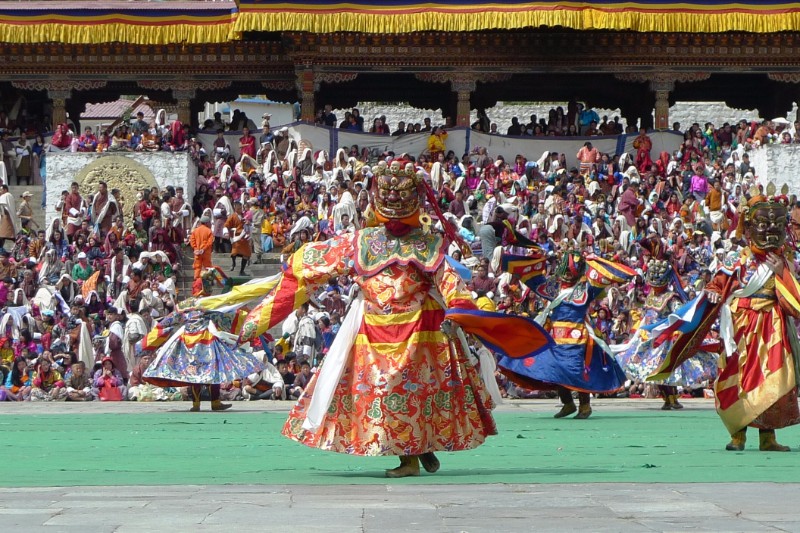
I squeezed my way to a front-row seat at Thimphu Tsechu to catch the iconic mask dances (Photo credit: Ryandall Lim)
Having gotten my dosage of close-up photographs, I strayed from the designated tourist section up the bleaches to a grassy patch behind them. Dozens of children in their colourful best were running around trees with plastic toy guns. Oblivious to the performances their parents had come to observe in order to accumulate merit, these kids were busy playing police and thief. Here too were groups of families enjoying food they had prepared especially for the day. The atmosphere was cheery. Most notably, smiles and laughter were abundant - and contagious - even as the glaring sun began to heat up Thimphu.
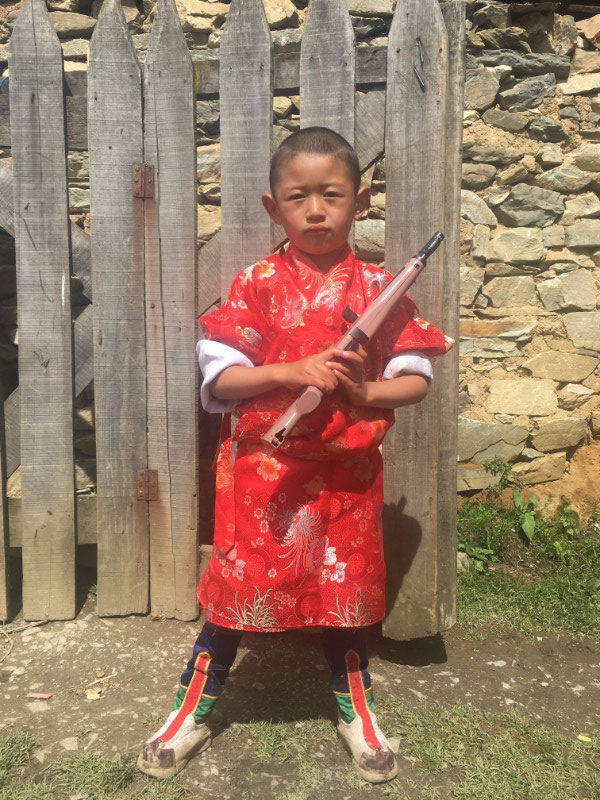
A little 'policeboy' strikes an intimidating pose (Photo credit: Ryandall Lim)
2. My dad is stronger than yours
After a long day immortalising Punakha’s many picture-postcard attractions, we headed to my hill-top hotel with amazing views of Punakha’s iconic dzong and the lively Mo Chhu and Pho Chhu rivers. Children in school uniform were walking downhill, presumably after their late afternoon classes.
While Keunzang and my trusted driver Chateo assisted with my check in, I accosted a bunch of chatty schoolboys outside the hotel entrance and asked if I could photograph against pretty Punakha in the background. To my surprise – and humour - they obliged without hesitation, and enthusiastically began striking poses, as if they were vying for Bhutan’s Next Top Primary School Model.
I showed them the picture I took, and commented that they all looked so handsome. As if on cue, they started to one-up each other in mock rivalry, trying to convince me who deserved the most dashing title.
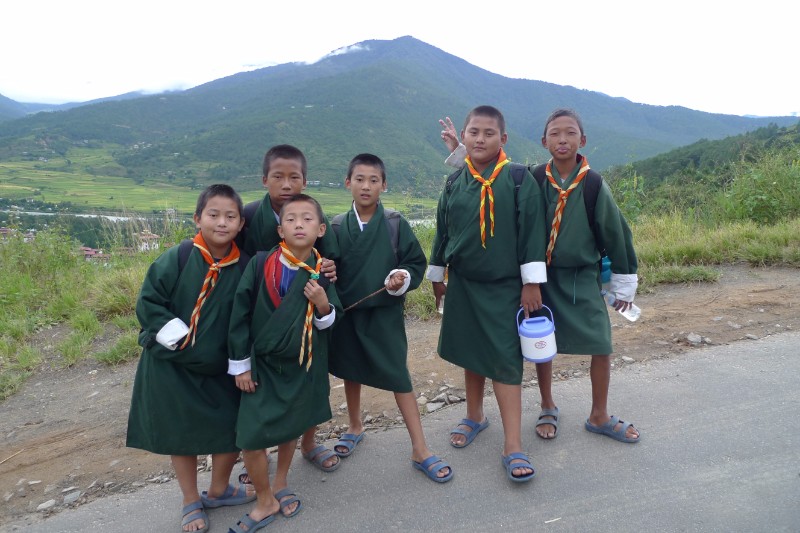
I accosted this chatty bunch for a photograph, but they ended up jostling for my attention instead (Photo credit: Ryandall Lim)
They went on to brag about their ambitions, their fathers’ strengths, their houses, among many other things, in unadulterated, child-like innocence. Even after waving goodbye, they continued their cheeky banter.
The sun had just set, and lofty Punakha Dzong was now flood-lit in a splendid glow. It too was competing for my attention.
3. Beauties and beasts
My day-trip to Gangtey was decidedly harrowing - for the first half of it, at least. We seemed to be constantly ascending and descending winding mountain roads, and Chateo only slowed down when vehicles approached from the opposite direction on the barrier-less single lane. I must admit he was quite the expert, but I somehow had the feeling he was conjuring Lewis Hamilton.
I recall looking out of the window from the back seat, and noticing the steep tree-covered ravine barely centimetres away from the car’s tyres, hastily shifting to the other side to prevent a possible perilous tip. In doing so I caused a weight redistribution, which resulted in Chateo giving me an inevitable glare via the rear view mirror. I was so anxious, I sat in silence; and for someone who does not need a reason to talk, that made me quite uncomfortable. But my nerves were soon abated by the sight of many small, calming waterfalls flowing down the hills.

The winding road to Gangtey is dotted with pretty cascading waterfalls (Photo credit: Ryandall Lim)
As we approached a particularly grassy bend speckled with tiny yellow wildflowers, a small, brown, antlered beast made quick eye contact with us from a distance, before scampering into the bushes. When we stopped to answer nature’s call, three curious long-tailed magpies peeped from the branches above, then swiftly flew away, as if embarrassed at the sight.
Earlier, en-route to Chimi Lhakang or the kinky Divine Madman’s temple, I photographed a butterfly showing off its luminous wings. The night before, a ghastly, ultra-leggy centipede made an unwelcomed visit into my hotel room. It felt almost unnatural being so close to these indigenous beauties and beasts.
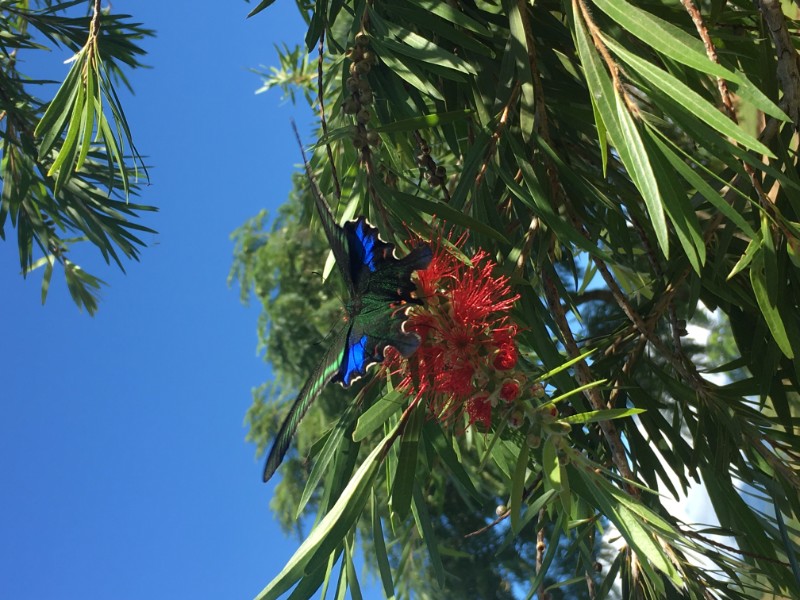
Nature at its brightest and most beautiful (Photo credit: Ryandall Lim)
4. Fields of gold
After an eventful day at Gangtey (I witnessed my second tsechu, visited Phobjikha Valley - roosting grounds of the endangered black-necked cranes, and made some quick cash gambling at the festival fair – much to the chagrin of some locals who had been trying their luck for hours!), we returned to Punakha, where I spent my night in a rustic but cosy farmhouse.
The spartan home was altered to include tourist-comforts like hot water supply, in-room power sockets, and a snug floor mattress covered in crisp white sheets, with fluffy pillows and a plush comforter. My young host couple explained that they wanted to give visitors a sneak peek into their lives, so they hung up their farm boots, leased out part of their land, and started their entrepreneurial venture – the village’s first home-stay.
Tshering, and his wife Dago, a business communications graduate, were incredibly hospitable, and fed me so much that evening I felt like I was being fattened to become someone else’s festive meal. After several rounds of post-supper rice wine (brewed in-house by their sweet, toothy grandmother), I was knocked out completely like sleeping beauty.
Next dawn, awoken by a chorus of chirping birds and barking dogs, I crept out of the farmhouse just in time to witness streaks of sun rays knight the surrounding padi terraces, transforming them into brilliant fields of gold.
In the horizon, a jagged mountain range whose shadowy peaks were until seconds ago shrouded in mist, now stared back intently at me. The cool morning air smelled somewhat recognisable in parts, yet still inviting – like a blend of crisp dried flowers, wild vegetables, a hint of wet soil, and a dash of manure – ah yes, a potpourri of nature.
One after another, farmers streamed out in their tractors, children marched to school, while the younger ones frolicked in their god-given, dragonfly-darting playground. Against the odd symphony of chirps and barks, Punakha had stirred to life in a 360-degree, multiple-sensorial curtain raiser just for me.
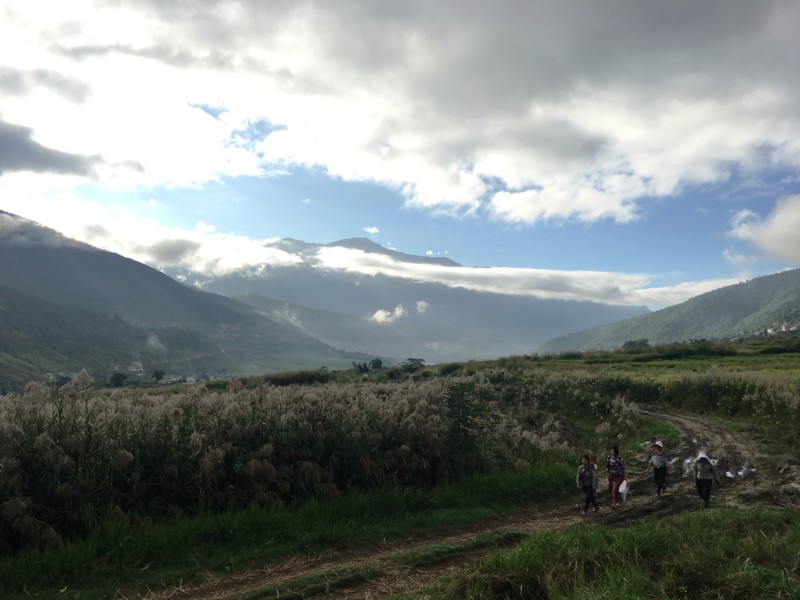
Farmers beginning their day as Punakha awakes (Photo credit: Ryandall Lim)
5. Chasing unicorns
We made a pit-stop at Thimphu on the way to Haa so that I could tick off several other touristy must-dos on my list: make cheesy-looking personal stamps, see Bhutan’s national animal - the quizzical takin up close, and document the city’s “dancing cop”. Raised in a country where order is conditioned by laws, signs and fines, I found it completely refreshing to see motorists obediently wait for their turn simply by observing the swaying, hypnotic white-gloved hands of a policeman standing under a pavilion in the middle of the world’s only stoplight-free capital.
As we made our way up Chele La Pass in the late afternoon, I was not expectant: it had been cloudy all day, and my previous attempts to see even one clear mountain peak – at Dochula Pass, and during my flight here – had been unsuccessful. I was mentally taking note of the many ominous speed-warning road signs like “One who drives like hell is bound to get there” when I noticed a peculiar cloud that looked quite odd. Then it struck me – that was no cloud.
“What is that?” I asked.
There was a pregnant pause as both Kuenzang and Chateo tried to identify what I was pointing at, in the glaring horizon.
“That’s Jomolhari! I think we better stop here so you can take a photo quick before the clouds cover it!” Chateo was obviously excited - his voice was a pitch higher suddenly. I took some consolatory pictures but because we were still 8km from the top, the view was slightly obscured by trees. The two locals were now determined to chase Jomolhari and show it off from the top of Chele La Pass to their guest. And so they did.
But not only did we catch Bhutan’s highest mountain in its snow-capped majesty, Mother Nature had something else in store for us. The funny thing is, I was viewing Jomolhari through my camera lens for the longest time that at first I did not realise a rainbow had appeared next to it. When I put my camera down to take it all in, I finally saw that a full arc had formed – and it was getting more radiant by the second! As if one complete rainbow was not rare enough, another appeared on top of it. Now, even the dark cloud by its side looked like a sleeping dragon.
We were the only ones on Chele La Pass at that fantasy moment. It was chilly but I felt warm; and despite the fluttering prayer flags around us, there was a surreal sound of silence. I was pretty sure even unicorns were lurking somewhere around.

A glimpse of fantasy at Chele La Pass (Photo credit: Ryandall Lim)
6. Tea of philosophy
The most exhausting - but exhilarating - day was kept to the last, when we made our way, together with hundreds of others, to Bhutan’s most iconic monastery.
For almost two hours, I was accompanied most intimately by my own loud pants and burning thigh muscles - which threatened to revolt and cramp as I got closer to my goal. There was no easy way to get there; even the privileged ones who sat horses could only go half-way. From there, we were all equals again, on our individual foot journeys to Taktshang Goemba - the fairy-tale Tiger’s Nest.
When we reached the look-out point, monks in the monastery had just begun a ceremony. Maybe I was overly dramatic but I was quite sure the echo of their chants through the mountains slowed my breathing down. Strangely, I also suddenly noticed how green the hills were, how sweet the air was, and how it did not matter anymore if I went all the way into the monastery or not.
I climbed onto a big boulder and sat staring at the mythical vision carved spectacularly into a soaring cliff-face. Kuenzang was next to me, but he was quiet. I think he knew I was having a spiritual moment.
Tiger’s Nest is probably best appreciated at a distance, in a state of calm, without my own deep breaths deafening me or drowning my thoughts. After a few souvenir photographs, we headed back to the tea-house. Now, connected and renewed by a shared experience, we talked about life, future, and philosophy over cups of tea – catching up like old friends from a previous life.
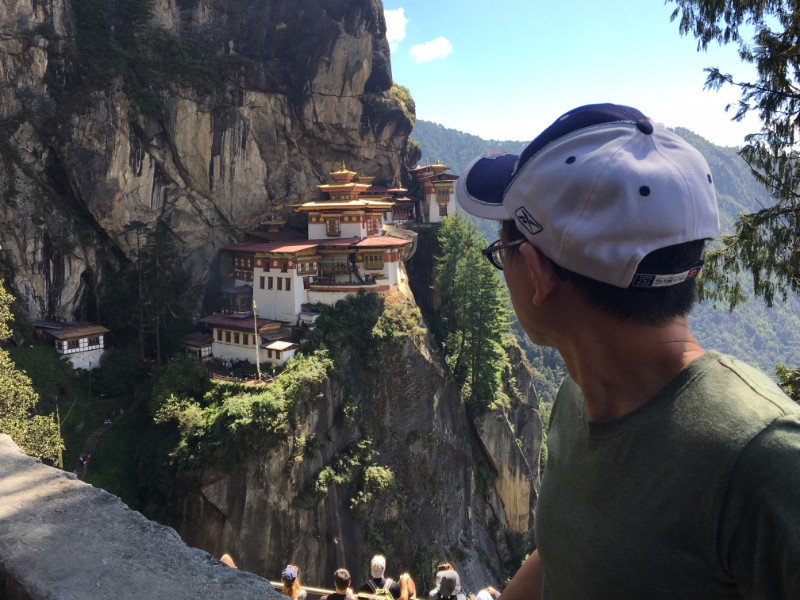
Having a private moment with the Tiger's Nest (Photo credit: Ryandall Lim)
7. From the heavens
My flight out of Paro was at an unearthly morning hour, but I short-changed myself a couple of minutes’ sleep on purpose just so I could arrive earlier at check-in and guarantee a window seat. Like déjà vu, the view at takeoff was the splendid patchwork of green hills and steep cliffs that welcomed me a week ago.
A couple of minutes later, we soared through the first cloud layer and this time, it was blue skies ahead. Then, little white pyramids started to appear as if floating on the thick mesh of clouds. I thought it was a mirage but I noticed the passenger behind me clicking away on her camera. Soon, that guidebook-rhetoric picture of jaw-dropping mountains which evaded me upon arrival was etched like a painting on my window. I was looking down at the roof of the world, in all its glory. They were far in the horizon, but the morning sun rays made sure to reflect their snowy peaks like dazzling beacons.
All good things must come to a temporary end, so the plane tilted away and left that stunning scene behind. It was heaven’s goodbye gift for this plane load of visitors who had come to see what happiness looked like.
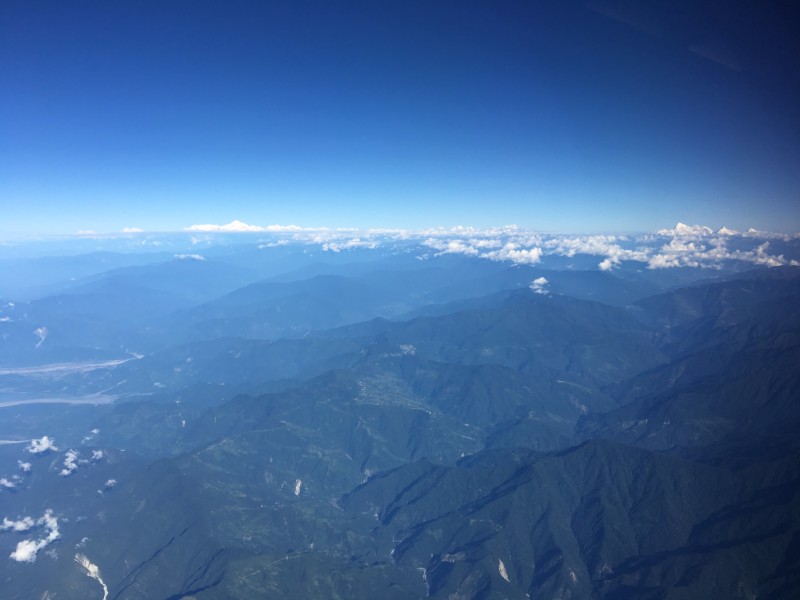
My trip wrapped up with a humbling sight of the world's rooftop (Photo credit: Ryandall Lim)
Bhutan taught me that I did not have to be religious to be spiritual; it is all about appreciating and living in the present. I saw how people connected to one other, their surroundings, their situations, and drew contentment from them.
But above all, those magical moments I chanced upon will remain especially unforgettable. They made me feel infinitely vulnerable - like a miniscule, drifting speck making my own journey alongside billions of others, in a mighty adventure called life.
For some time, I did not quite get what French philosopher Pierre Teilhard de Chardin meant when he said: “we are not human beings on a spiritual experience; we are spiritual beings on a human experience”.
By the end of my trip to the Land of the Thunder Dragon, I understood.
Conclusion About Spirit Of Bhutan
Experience the spirit of Bhutan during Tshechu with our Bhutan travel packages. Plan your visit by knowing the best time to travel to Bhutan and managing your budget with insights on the Bhutan travel cost. For a luxurious Tshechu experience, explore our luxury travel in Bhutan options. If you're travelling from Malaysia, our guide on travel to Bhutan from Malaysia provides valuable information. Druk Asia, the best Bhutan travel agency, is here to ensure your Tshechu experience is unforgettable.
